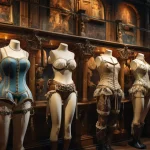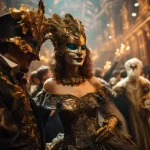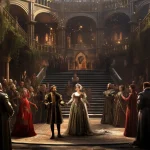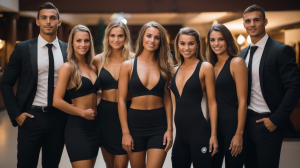
Reviving the Past: Exploring Historical Fashion Trends in the Modern World
Ah, the world of fashion, my friends, it’s like a carousel, always spinning, always bringing back the old to blend with the new. It’s downright fascinating, isn’t it? You see, fashion, it’s not just about clothes, it’s a journey through time. 🕰️ We see these trends, once the toast of the town, come back, not just as relics, but reborn, with a modern flair.
Now, think about this – when you look at these styles from yesteryears making a comeback, it’s like stepping into a time machine. There’s a certain magic, a charm to it, pulling threads from the past and weaving them into today’s tapestry. It’s not just about mimicking old styles; it’s about celebrating them, breathing new life into them. And that, my friends, is a beautiful thing.
Dive into the annals of fashion history, and you’ll see it’s more than just garments; it’s a narrative, a story that keeps evolving. Each era, each style, it tells us something, about where we’ve been, and maybe even where we’re headed. So, let’s tip our hats to the timeless elegance of the past, and let’s not just wear clothes, let’s tell stories with them. After all, fashion is a language, one that speaks volumes about our collective journey through time. 🎩👗
So, here’s to fashion, an ever-evolving, ever-inspiring art form, a bridge between the past and present, making sure every stitch, every pattern has a story to tell. Let’s keep spinning on this carousel of style, shall we? 🎠👚👖
The Cyclical Nature of Fashion Trends
Fashion, oh it’s like a spinning wheel, isn’t it? Always rolling back around to where it started. Historical styles, they make a comeback, but with a fresh twist, a new perspective. 🔄 It’s like a dance between the past and the present, each step influenced by a longing for the good old days, cultural shifts, and that eternal quest for something timeless, something that stands out.
Take a stroll down memory lane, and you’ll see those flared jeans from the ’70s strutting their stuff again. And it’s not just the clothes themselves; it’s the spirit they carry, a blast from the past, rekindled and reshaped for today. 🕺💃
Now, let’s not forget the power of those stars and influencers, the trendsetters. They’ve got this knack for digging up gems from bygone eras, dusting them off, and thrusting them back into the limelight. And just like that, what’s old is new again.
Take the ’90s, for instance. Suddenly, we’re seeing choker necklaces, slip dresses, and those high-waisted jeans everywhere. It’s like a wave of nostalgia crashing over us, fueled by the folks we admire, those who set the trends. It’s fascinating, isn’t it? How the past can be repackaged, refreshed, and served up to a whole new generation. 🌊👖
This cyclical dance of fashion, it’s more than just recycling old trends. It’s about reinterpreting, reimagining what once was, and giving it a new heartbeat. It’s about connecting threads from different times, creating something unique, something that resonates with the here and now. So, let’s embrace this ever-turning wheel of fashion, where the past is always present, and every style tells a story. 🎡🧵👗
Popular Historical Fashion Eras and Their Influence
Ah, the world of fashion, it’s rich with threads from different times, each era leaving its unique stitch in the fabric of modern style. 🧵🌟 Let’s take a little journey through these fashion epochs, shall we?
The Roaring Twenties, what a time that was! Flapper dresses shimmying, drop waistlines redefining silhouettes, and Art Deco adding its geometric charm. It was a revolution, not just in fashion but in spirit, a bold statement of liberation and defiance against the old guard. It’s like those styles whispered, “Be free, be daring!” 💃🍸
Then, whisk forward to the 1950s, the age of elegance and grace. Ah, the hourglass figure, celebrated in full skirts and Dior’s New Look. It was a time when fashion embraced femininity like a long-lost friend, with each garment singing a song of structured glamour. 👗✨
The 1970s, oh what a colorful chapter! Bohemian fashion waving its flag of freedom, wide-leg pants strutting the streets, and disco styles glittering under the ballroom lights. This era, it wasn’t just about clothes; it was a canvas for self-expression, a loud, proud shout of individuality. 🌼🕺
Each of these eras, they’re like timeless muses for today’s designers. You see elements of the past waltzing into modern collections, creating this mesmerizing dance of old and new. Look at the bohemian vibes of the ’70s making their comeback. Flowy maxi dresses, fringes that seem to dance with every step, and floral prints blooming in wardrobes once again. It’s like history repeating itself, but with a fresh, contemporary beat.
This isn’t just fashion; it’s a cultural echo, resonating through time, reaching out to new generations, inviting them to take a piece of the past and make it their own. It’s a celebration, a recognition that while times change, the essence of style, its soul, remains eternal. So, let’s raise a glass to these historical fashion eras, the architects of our modern style. 🥂👠🕶️
Incorporating Historical Elements into Modern Fashion
In the world of fashion, it’s like a grand ball where the past and present waltz together in harmony. Designers, those maestros of style, they have a knack for taking a pinch of history and blending it with a dash of the contemporary. 🎨👗
Let’s consider the likes of Gucci and Alexander McQueen. They’re like time-travelers, journeying through the annals of fashion, picking elements from different eras, and then, with a swish of their designer wands, transform them into something utterly modern, yet steeped in history. It’s not just about replicating the old; it’s about reinterpreting it, giving it a new voice in today’s fashion narrative. 🔄🌐
Now, bringing history into your personal style, that’s an art in itself. Imagine this: a vintage blouse, its fabric whispering tales of yesteryears, paired with a sleek, modern skirt. Or a contemporary outfit, accented with vintage-inspired accessories. It’s like a dialogue between the ages, each piece telling its own story, creating a style that’s as unique as a fingerprint. 👚👠
And then, there are these fascinating collaborations, where fashion meets history in the most literal sense. Take Louis Vuitton teaming up with the Musée du Louvre, for example. It’s not just a collection; it’s a cultural journey, a fusion of art, history, and fashion. These collaborations, they’re like bridges connecting the world of style with the rich tapestry of our cultural heritage, making sure that the elegance, the spirit of those bygone eras, is not just remembered, but celebrated and worn. 🏛️👘
In essence, fashion isn’t just about what we wear. It’s a living museum, a canvas where history and modernity paint together, creating garments that are not only nostalgic but also resonate with the pulse of the present. It’s a testament to the enduring power of style, transcending time and trends. 🕰️🧵🌟
Tips for Incorporating Historical Trends into Personal Style
Diving into the world of historical fashion and weaving it into your own style, now that’s an adventure, a kind of sartorial time travel. Let me guide you through some steps to create a wardrobe that’s as unique as a rare gem.
- Start Small, Start Smart: You don’t have to go full throttle into a bygone era right away. Begin with little touches, like a sprinkle of historical charm. How about a vintage brooch pinned neatly on a modern blazer? Or maybe those retro sunglasses that whisper of a summer in the ’60s? These small elements, they’re like time capsules, adding a story to your outfit without overwhelming it. 🕶️🧷
- A Fusion of Times: Now, here’s where the fun begins – mixing different eras. It’s like being a DJ, but with clothes. Imagine blending a Victorian blouse, all lace and high collars, with something as timeless as high-waisted jeans. The result? A look that’s both modern and steeped in history, a style that speaks volumes about your unique fashion narrative. 🎩👖
- Seek and You Shall Find Inspiration: The world around you is brimming with ideas. Movies, art, those icons who turned heads with their style – they’re all treasure troves of inspiration. Delve into films from different periods, soak in the aesthetics, the vibe. Understand the stories behind the styles. It’s not just about how it looks; it’s about the why, the context that gave birth to these trends. 🎥🎨
Remember, incorporating historical elements into your style is not just about dressing up; it’s about storytelling, about wearing a piece of history and making it your own. So go ahead, play with time, mix and match, and most importantly, have fun with it. Your wardrobe is your canvas, and history offers an endless palette of styles. Paint away! 🖌️👗🌈
The Impact of Sustainability and Ethical Fashion on Historical Trend Revival
The intersection of historical fashion and the movement towards sustainability and ethical practices in the industry is a remarkable evolution. It’s a confluence of respect for the past, responsibility towards the future, and a keen eye for style.
- Sustainability Meets Style: Vintage and second-hand clothing are not just relics of the past; they’re beacons of sustainability. By choosing these pieces, we’re not just making a fashion statement; we’re also taking a stand for the environment. It’s about slowing down the frantic pace of the fashion cycle, reducing waste, and giving a new life to garments that were made to last. Vintage fashion is timeless, not just in style but in durability, embodying the essence of slow fashion. 🌍♻️
- Ethical Fashion, Timeless Appeal: Opting for historical trends is more than a style choice; it’s a moral stance. In a world grappling with the consequences of fast fashion – unfair labor practices, environmental damage – choosing vintage or second-hand clothing is a way of saying, “I care.” It’s about conscious consumption, choosing garments that have a story, a heritage, rather than something churned out in an impersonal factory. It’s a celebration of individuality and ethical responsibility. 👚🌱
- Innovation in Design: Designers today aren’t just looking back for inspiration; they’re looking forward to how they can blend the old with the new responsibly. It’s about marrying the aesthetics of yesteryears with sustainable materials and ethical production practices. This creative challenge is leading to exciting innovations in fashion, where the charm of the past meets the consciousness of the present. It’s a testament to the fact that being fashion-forward also means being environmentally and socially mindful. 🎨🌿
This revival of historical trends in the context of sustainability and ethics is a powerful statement. It shows that fashion can honor its past, address its present challenges, and pave the way for a future that’s both stylish and sustainable. It’s not just about wearing clothes; it’s about wearing values. 🌟👖🌏
The Future of Historical Fashion Revival
You know, advancements in technology and manufacturing, they’re like the unsung heroes in the world of fashion. We’re on the cusp of a new era where the old and the new aren’t just meeting; they’re shaking hands and creating something spectacular. Emerging designers, they’re the trailblazers, the kind of folks who look at a piece of fabric and see a story. They’re not just reviving historical trends; they’re giving them a whole new lease on life.
As we move through this ever-changing landscape, it’s crucial to remember where we came from. Fashion isn’t just about the latest trends; it’s about heritage, about the craftsmanship that’s been passed down through generations. It’s a testament to human creativity and ingenuity. By looking back, we’re not just reminiscing; we’re learning, we’re appreciating the foundation on which modern fashion is built.
The future of fashion, it’s not just about looking good. It’s about making choices that are good for our planet, good for the people who make our clothes. It’s about sustainable and ethical practices that honor the past while looking out for our future. So, as we stand at this crossroads, let’s make sure we’re taking the best of what history has taught us and blending it with a responsible vision for tomorrow. That’s how we’ll keep the legacy of fashion alive and well, not just as a reflection of our style, but as a reflection of our values.
Reviving historical trends, it’s like opening a treasure chest of styles from days gone by. This isn’t just about clothes; it’s about bringing a piece of history back to life, right in our modern world. Fashion, it’s got this way of coming full circle, bringing back those classic looks with a twist of today. It’s a bit like a boomerang – you throw it out, and sure enough, it comes back, but with a new story to tell.
When we weave these historical elements into our own style, it’s not just about standing out; it’s about connecting. It’s about wearing a piece of the past and making it a part of our story. It’s personal, you know? It’s like saying, “This is who I am, and this is a part of where I’ve come from.” It’s individuality, etched in the threads of time.
So, every time we choose to bring back a style from the past, we’re not just following a trend. We’re celebrating a legacy, a moment in time that shaped fashion as we know it. We’re paying homage to the artisans, the trailblazers who stitched and sewed, who dared to dream in color and texture. And in doing so, we keep the beauty of the past alive, not just as a memory, but as a living, breathing part of our everyday lives.






